TechRadar Verdict
The performance is impressive from the outset, and when it comes to AI-enhanced features in applications such as Premiere Pro and Photoshop, this machine doesn't fail to impress. The only time it starts to falter is when gaming, where the small size does seem to throttle the speed. However, this is only notable when gaming; otherwise, the performance and abilities are impressive throughout.
Pros
- +
Powerful multitasking performance
- +
Compact premium design
- +
AI acceleration
Cons
- -
No discrete graphics
- -
Higher base cost
- -
Noticeable fan noise
Why you can trust TechRadar
Sapphire Edge AI 370: 30-second review
Out of the box, this is one of the smallest mini PCs that I've looked at, which is even more impressive considering it's got one of the most powerful CPU/GPU combos on the market for this style of machine. What's more, as I put the EDGE AI 370 to test, running through the benchmarks and real-world tests, the processing power didn't fail to impress.
The retail version of the machine arrives as a barebones system with three different options, and in this review, I've looked at the Sapphire Edge AI 370 model. This features the AMD Ryzen AI 9 HX 370 with the integrated Radeon 890M GPU as well as an NPU for AI acceleration.
While the machine is available as a barebones-only option, my review sample arrived with 32GB of RAM, complemented by a 1TB SSD with Windows 11 Pro installed and a copy of Ubuntu that I installed on another SSD to test another operating system and its potential for development.
Before getting into the performance of the machine, the first thing that really stands out is that whilst it is extremely small, it's also well thought through in terms of connectivity, with two USB Type-A ports on the front alongside a 3.5mm audio jack. For a machine at this level, it's a bit of a shame there isn't also a USB-C port of some denomination. Around the back, the level of ports is impressive considering the small size. There are two HDMI ports, more USB Type-A ports, and two USB4 ports alongside the LAN and the DC in, giving you plenty of options for expansion and connecting into larger systems.
Looking at the benchmarking tests, it's instantly apparent that despite the size, this was one of the most powerful mini PCs that I've ever tested, getting some of the highest results I've seen, very close to some of the more powerful laptops and mid-range desktops. The CPU performance stood out, and while the GPU does hold it back slightly, with the assistance of the NPU, especially in creative applications from Adobe such as Premiere Pro and Photoshop, the speed at which it was able to process the content was impressive.
As expected, Windows performance alongside Microsoft Office was just about as good as you get, with files opening quickly and the ability to copy, paste and transfer files from external drives at speed. It's a bit of a shame that the network attachment is only 2.5G; it would've been good to see at least 5G, but still, for the size of the machine, that's not too much of a hindrance.
As I started to push the machine further, it was great to see just how well it handled video content creation and image editing. Editing short movie productions in Premiere Pro, utilising a Lexar ES5 external SSD, proved just how powerful this small machine was. However, the more you push it, the more the small internal fans kick in to keep things cool.
Sign up to the TechRadar Pro newsletter to get all the top news, opinion, features and guidance your business needs to succeed!
Where you do suddenly realise the restrictions of the small form factor is when you start to play games. With no discrete graphics and with that small form factor, playing games like Indiana Jones and the Great Circle or even Hogwarts Legacy quickly shows that, whilst this is an extremely powerful mini PC, with sustained pressure on the GPU, the smoothness of the graphics does falter. However, with that USB4 port it is possible to link up to an eGPU.
If you're looking for one of the best mini PCs for development, AI use, a compact workstation or as a content creation hub, then this machine is a great option. However, if you're looking to play some of the latest games and want an ultra-portable compact machine, then whilst this has the power, it isn't the solution.
Sapphire Edge AI 370: Price and availability
- How much does it cost? From £439 - Model Reviewed £649
- When is it out? Now
- Where can you get it? Widely available
The Sapphire Edge AI 9HX arrives as a barebones mini PC, so on top of the initial cost for the machine, you'll also need to factor in Windows 11 Home/Pro, an M.2 2280 SSD and RAM. In this review, I've looked at the EDGE AI 370, which costs £649.
Once you add a 1TB SSD at around £100, 32GB RAM at around £130, and the cost of Windows 11 Home at £120, you could be looking at just under £1000 for this review sample.
The barebones system is available in three options: the entry-level EDGE AI 340 at £439, the mid-range EDGE AI 350 at £539, and the option reviewed here, the EDGE AI 370 at £649.
- Value: 4 / 5
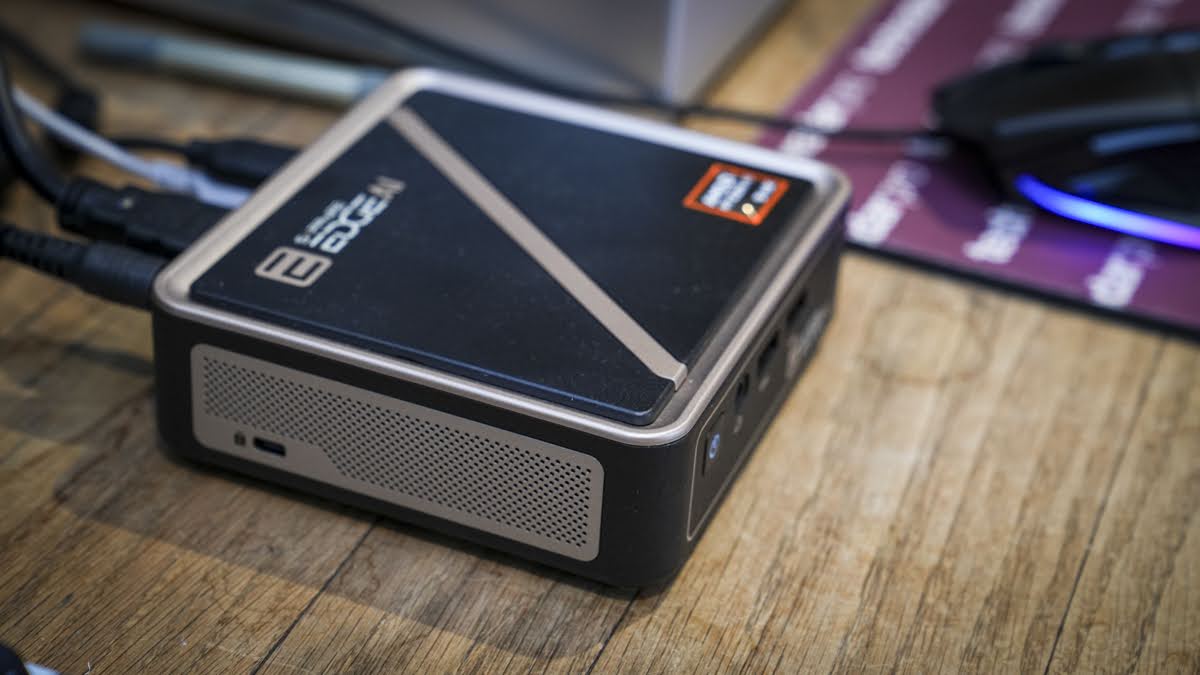
Sapphire Edge AI 370: Specs
CPU: AMD Ryzen AI 9 HX 370 (12C/24T, up to 5.1GHz)
Graphics: Radeon 890M (Integrated)
RAM: Non (DDR5 SO-DIMM dual-channel)
Storage: None (M.2 2280, 2242)
Left Ports: 2× USB-A 3.2 Gen2, Audio jack
Right Ports: 2× HDMI 2.1, 2× USB-C 4.0 (PD), 1× USB-A 3.2 Gen2, 1× USB 2.0, 1× RJ45 2.5Gbps Ethernet
Connectivity: WiFi + Bluetooth, 2.5G LAN
Audio: 3.5mm jack, HDMI audio
Camera: None
Size: 117 × 111 × 30 mm
OS Installed: None
Accessories: Power adapter (120W), VESA mounting kit
Sapphire Edge AI 370: Design
This is one of the best-looking mini PCs that I've reviewed. It's compact, small, and the aesthetic design just looks great. Not only that, but the build quality is excellent, and there's no doubt that this is a premium mini PC despite its compact size.
It's also available as a barebones-only system, which means that you have to decide on the RAM and SSD you put inside, with the ability to install up to 96GB of DDR5 SO-DIMM in the dual-channel slots. When it comes to SSDs, there are two slot options: an M.2 2280, which will hold up to 4TB, and an M.2 2242 that will take up to 2TB, enabling up to 6TB of internal storage.
What's surprising here is just how easy it is to upgrade both the RAM and the storage. The top plate of the mini PC is simply held in place by strong magnets, so just by putting your finger underneath, you can quickly pop the top off and gain direct access to the inner workings. If you need to upgrade, it will only take you a couple of minutes.
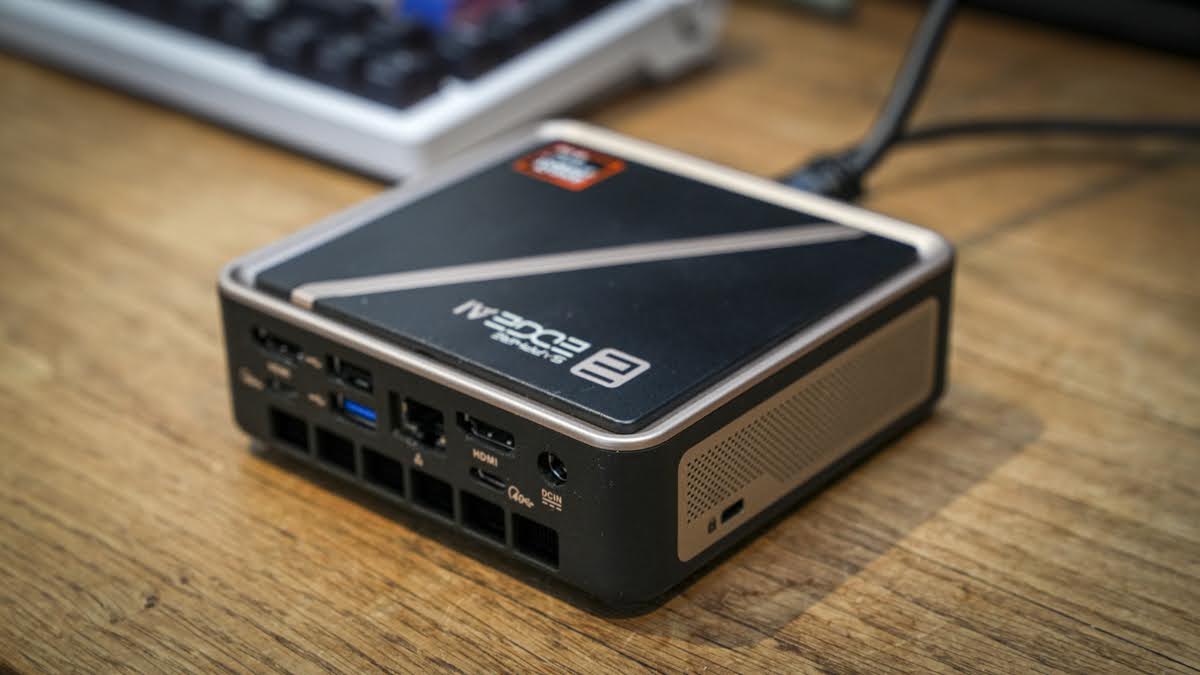
The actual size and weight measure in at 117 × 111 × 30 mm, so it's extremely small. If you want to pop it in your bag to take it from one location to another or utilise this as part of a portable workstation, that's perfectly possible, and while the AC power adapter is in the box, if you want to power it through the USB4 port than that is supported as long as you have a 100W input.
Looking at the front of the machine, there's a standard 3.5mm audio jack, two USB 3.2 Type-A Gen 2 ports, and the power button. As previously mentioned, it's a shame there's no USB-C port on the front.
At the back, there's the DC jack, two HDMI 2.1, two USB Type-C 4.0 (with PD 3.0), a USB 3.2 Type-A Gen 2, USB 2.0 Type-A, and for networking, an RJ45 (2.5G LAN).
- Design: 4.5 / 5
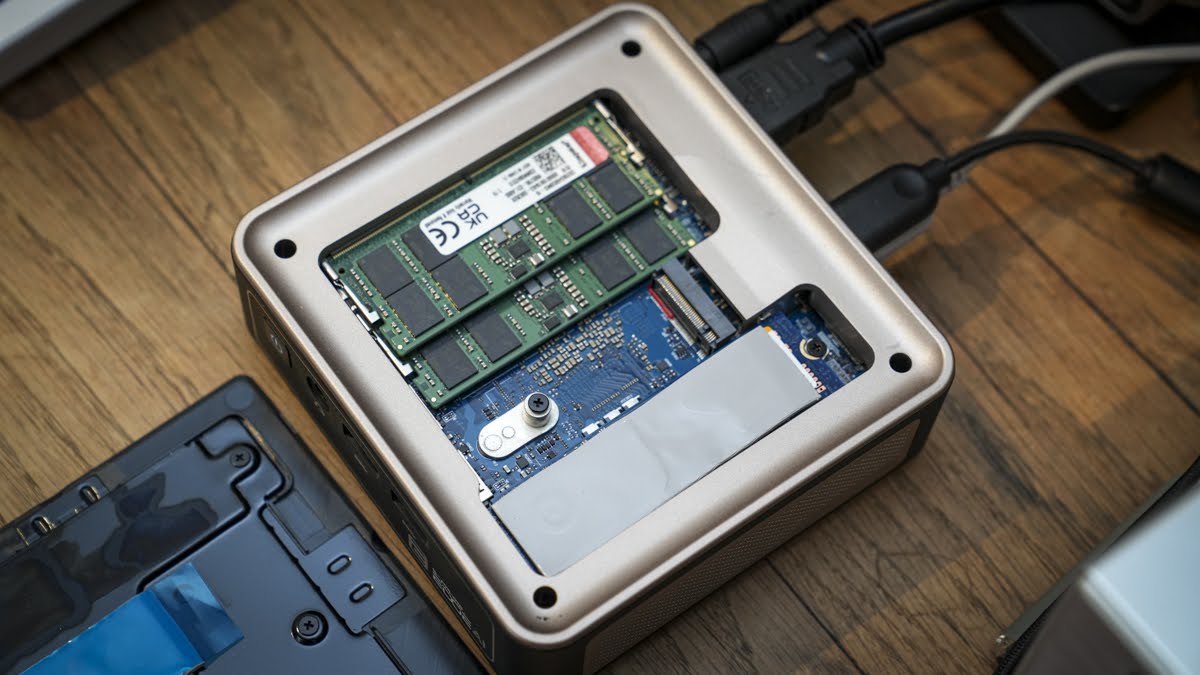
Sapphire Edge AI 370: Features
The main feature of the Sapphire Edge AI highlights the machine's AI credentials, the 50 TOPS AI performance with the AMD XDNA2 and NPU architecture processors. The AMD Ryzen AI 300 Series CPU, Ryzen AI 9 HX 370 (12 cores, 24 threads, 5.1GHz boost), is combined with the Radeon 800 GPU to provide a powerful processing core for this compact machine.
At present, the machine is only available as a barebones system, but it will support up to 96GB of DDR5 memory in the dual-channel slots.
Despite the size, it also has three M.2 slots: a standard M.2 2280 PCIe for the main drive, a smaller M.2 2242 for a secondary drive, and an M.2 2230, which contains the WiFi/Bluetooth card, so that it can be upgraded as and when needed.
The access to the inner workings has also been well thought through, with a powered magnetic lid being relatively easy to remove to gain access.
Another great feature to see is the dual HDMI 2.1 ports and USB4, enabling you to plug in up to four monitors at 4K resolution.
Finally, when it comes to connectivity, the machine offers WiFi 6E and Bluetooth 5.2, and again, as the hardware for these is contained on the M.2 card, it can be upgraded when needed.
A slight disappointment is that the machine only offers a 2.5G LAN connection. With the speed and quality of the machine's other components, I would have expected at least 5G. However, for connecting to the network in the studio, this does provide a robust connection.
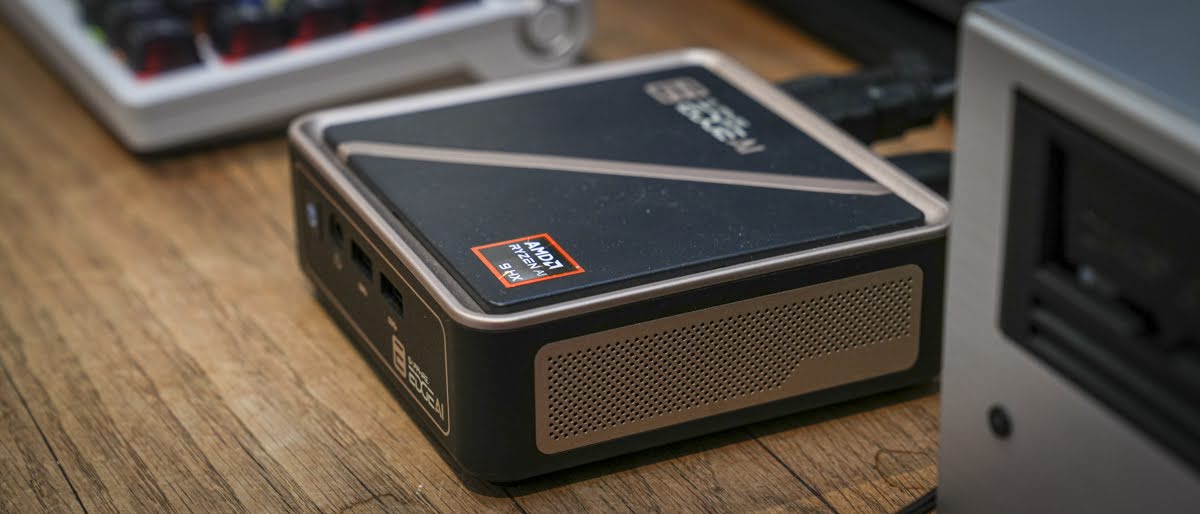
- Features: 4 / 5
Sapphire Edge AI 370: Performance
CrystalDiskMark Read: 5185.72 MB/s
CrystalDiskMark Write: 4733.12 MB/s
Geekbench CPU Multi: 12,711
Geekbench CPU Single: 2,548
Geekbench GPU: 29,604
PCMark Overall: 6,763
Cinebench CPU Multi: 16,354
Cinebench CPU Single: 1,732
Fire Strike Overall: 8,291
Fire Strike Graphics: 8,894
Fire Strike Physics: 27,633
Fire Strike Combined: 3,242
Time Spy Overall: 3,440
Time Spy Graphics: 3,084
Time Spy CPU: 9,961
Wild Life Overall: 18,454
Steel Nomad Overall: 528
Windows Experience Overall: 8.3
The small size, design, and promise of the power of the internal processor and GPU instantly make this an exciting machine to test. It promises a great deal, and the build quality instantly reinforces its premium positioning in the mini PC market.
My review sample arrived fully kitted out with 1TB of SSD storage and 32GB of RAM, 16GB in each slot. Through the test, I ran both Windows 11 Pro and Ubuntu to see how it would perform under the two operating systems.
Getting started with Windows took a few attempts, with the installation of the new machine requiring several restarts before completing fully. But once finished, and a series of Windows and driver updates completed, the speed of the machine was instantly apparent.
Running Windows 11 Pro, the machine booted quickly and launching Microsoft Office, along with the apps, proved just how fast the machine was. Each app opened quickly, and switching between Word, PowerPoint and Excel was fast with no hesitation.
It was obvious from the outset that standard apps wouldn't pose a challenge to the machine's processing power. Launching into Adobe Photoshop and Lightroom again proved that the machine had some serious clout when it came to thatprocessing power. Building up layers from images shot on the Sony A7 IV showed just how easily it was able to handlethe data, and connected to a 4K monitor, the quality of the display was excellent through either the HDMI or USB4 port.
In Photoshop and later in Premiere Pro, I tested the AI features with Generative Expand and Extend Video. While the speed of the processing was slower than my desktop machine, compared to a standard CPU-equipped mini PC there was a notable uplift in the application.
Again, piling on the pressure, I started to look at video editing, with the machine more than capable of handling complex HD editing. As I stepped up to a 15-minute 4K edit, the speed of the machine did start to falter, with a slowdown on the timeline as the complexity of the edit increased.
The Canon EOS R5 C footage was shot in C-Log 3, so the fact that it was able to handle it at all was impressive. As I reached the end of the edit, I was impressed by just how much you could do with the machine. It was definitely a step up from other compact mini PCs and, with the close match in specification to more premium models, put in decent all-round performance that was close to, if not slightly outperforming, the competition.
While the machine was able to handle the editing, it is worth noting that you would need to adapt the SSD capacity for video editing and production, as 1TB is just too small. You can connect an external SSD such as the Lexar ES5 Magnetic Portable SSD to give storage a boost, but in reality, a decent capacity M.2 SSD would be the best approach.
The other note I made when editing was that as the processors start to warm, the fans kick in. While these are well managed and not overly loud, they are noticeable, so again, if you like to have a quiet editing environment, a full-sized desktop is the better approach.
Of course, I couldn't finish a test without trying out a few games on the system, especially when the speed and power of the machine had been exceptional through all other tests. Here I was a little surprised. While the games Dirt Rally, Hogwarts Legacy, and Indiana Jones and the Great Circle all looked great and were playable, there was a slight stutter in the action. This stutter would happen consistently, and delving into the settings and reducing the quality made an instant improvement.
So, while this machine has huge potential for developers, content creators and high-demand office work, the limitations of the size and form factor are highlighted by the constant processor demands of games.
- Performance: 4.5 / 5
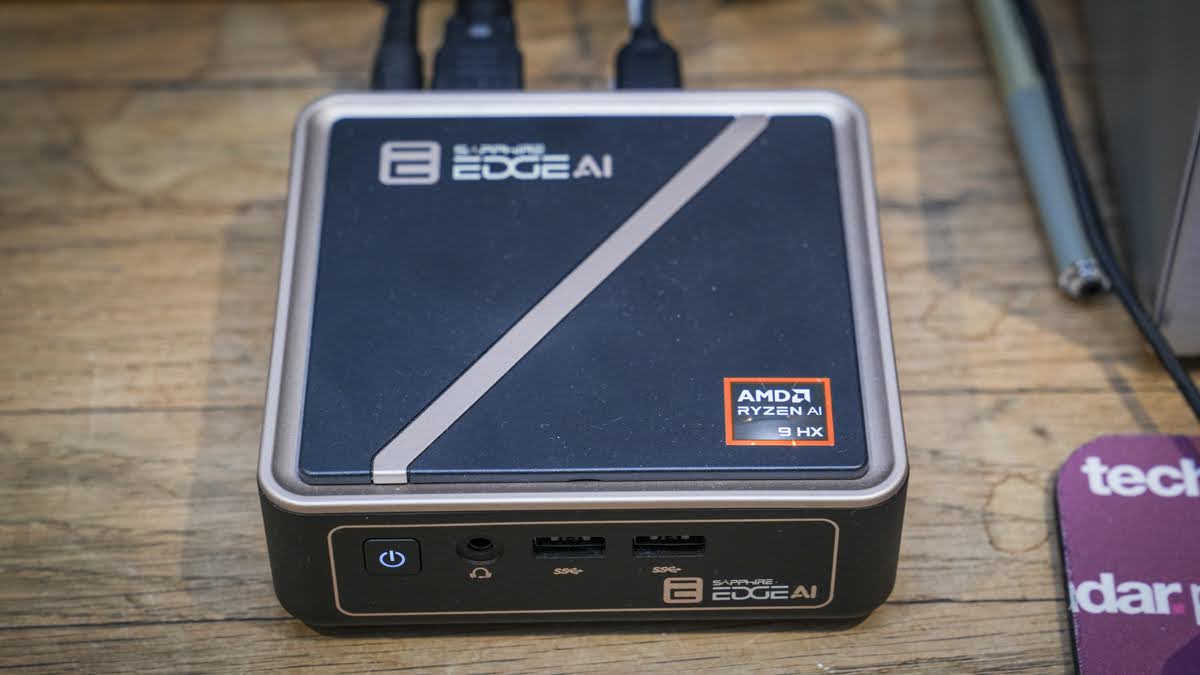
Sapphire Edge AI 370: Final verdict
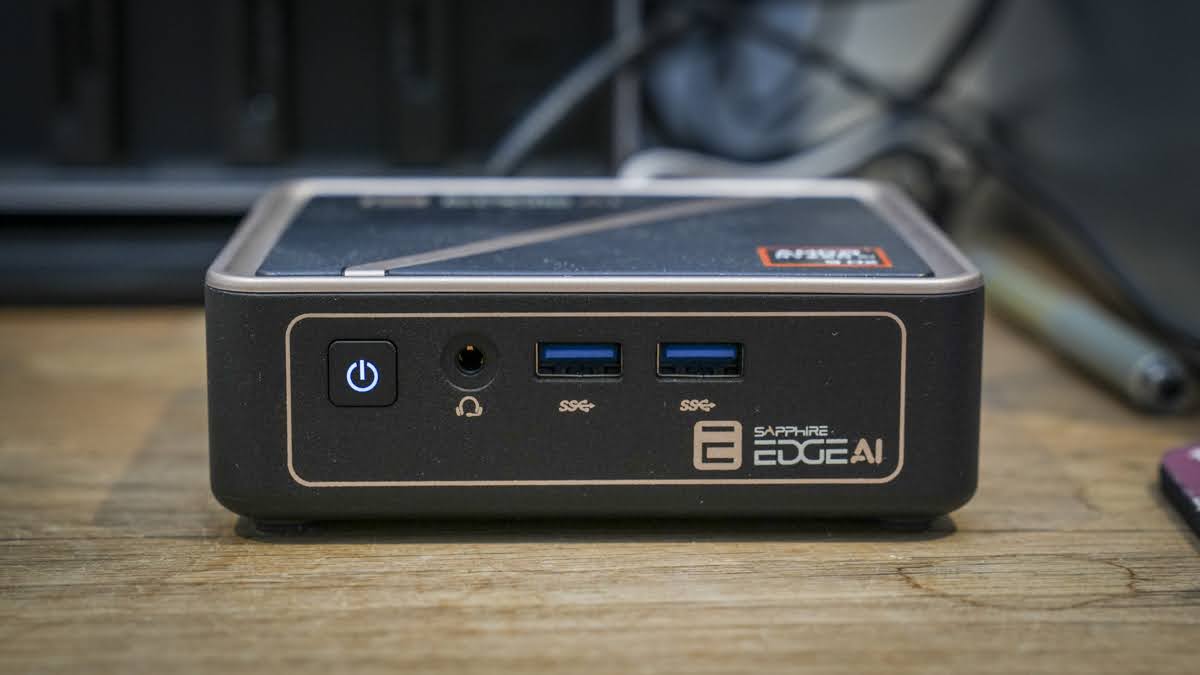
By the end of the test there was a lot that impressed me about the Sapphire Edge AI 370, with the size, power and style really standing out. The fact that machine is so small makes it highly portable and in work situation where small and lightweight are essential this Mini PC absolutely stands out.
However, while the machine is small it's also extremely powerful and at present is one of only a few Mini PC's that is available as a barebone system only. This means that you essentially pick your choice of processor and then install the RAM and SSD that you want to compliment.
In the review sample the 32GB or RAM and 1TB SSD felt like a good start point, and a perfect solution for any office where the machines are going to need a little more power than that needed for simple processing. Then with plenty of options to expand the internal storage to 6TB and with the USB4 port at the back you can further boost the potential, not only with storage but also by connecting up to a more powerful eGPU.
This is where this Mini PC gets really interesting, you can essentially adapt it to your needs, if your an office worker then it's a small compact box that you can neatly tuck away out of site. If however you want to use it for content creation then adding larger SSDs and RAM will enable you plenty of production scope, and if you want to play high end games, then, while you can with the integrated GPU and settings on low, attach an eGPU for a turbo charge.
Of course this means that the Sapphire Edge AI 370 has plenty of potential, but that does come at a cost and as you start to pile on the additional storage, RAM and eGPU then that will obviously boost the price, close to that of a very decent desktop.
Still, by the end of the test I was impressed and this is one of the best Mini PC solutions for anyone looking for a powerful machine with plenty of flexibility for everything from day-to-day office work, through to content creation and gaming.
Should I buy a Sapphire Edge AI 370?
Value | Highly specced machine that's available in three options, but decidedly premium in price | 4 |
Design | Extremely compact and easy to upgrade with your own equipment | 4.5 |
Features | Huge AI potential, but at present slightly ahead of the game | 4 |
Performance | Incredibly fast for all tasks other than gaming | 4.5 |
Overalls | Superb AI performance in creative applications. Small size makes it an ideal portable choice | 4.5/5 |
Buy it if...
You need a Space-saving mini PC
You need workstation-grade performance in a palm-sized box for office, creative, or dev work without the bulk.
You want a machine that's AI-ready
You're building or experimenting with AI-enhanced applications and want onboard NPU acceleration in a quiet mini PC.
Don't buy it if...
You're running GPU-intensive workloads
You rely on CUDA or need high-end rendering/gaming performance; this integrated GPU won't replace a discrete RTX card.
You want something for basic home use
You're mostly browsing, doing email, or media playback — better value exists in cheaper mini PCs without the AI focus.
Alastair is a photographer, filmmaker and tech writer who has been working in the publishing industry since the late 1990s. For more than 25 years he has covered photography, video and technology across Future's photography, technology and gaming brands. He runs a photography and video production company and lectures in TV and film. He can usually be found testing mini PCs or prototyping and prop building with the aid of 3D printing.
You must confirm your public display name before commenting
Please logout and then login again, you will then be prompted to enter your display name.